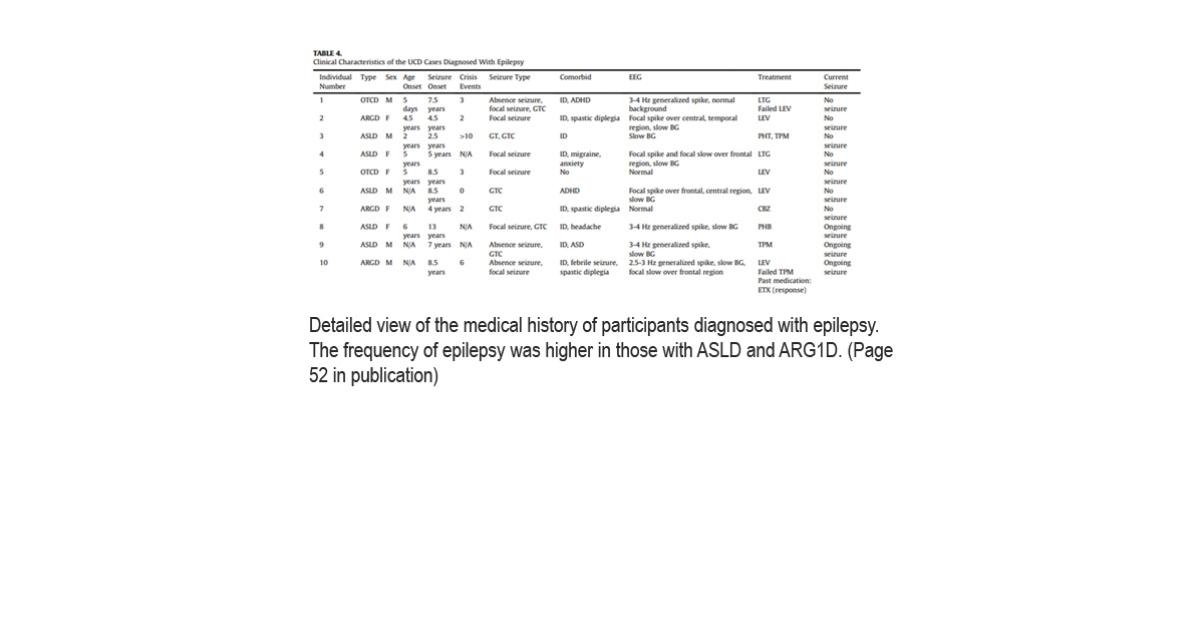Chanvanichtrakool M, Schreiber JM, Chen WL, Barber J, Zhang A, Ah Mew N, Schulze A, Wilkening G, Nagamani SCS, Gropman A; Urea Cycle Disease Consortium. Unraveling the Link: Seizure Characteristics and Ammonia Levels in Urea Cycle Disorder During Hyperammonemic Crises. Pediatr Neurol. 2024 Oct;159:48-55. doi: 10.1016/j.pediatrneurol.2024.06.013. Epub 2024 Jun 29. PMID: 39121557; PMCID: PMC11381174.
High ammonia levels in people with UCDs can trigger seizures and increase the risk of epilepsy, especially in those with late-onset seizures. This study suggests the need for regular EEG monitoring to detect both visible and hidden (subclinical) seizures, which can help prevent brain damage and improve patient care.
Key Takeaways:
- EEG monitoring is useful during high ammonia crises for visible seizures and seizures without noticeable symptoms, which can both lead to brain damage.
- Seizures were observed in 34% of participants; epilepsy was diagnosed in 12% of patients.
- Rising ammonia and glutamine levels were strongly linked to seizures.
- Measurement of initial ammonia and glutamine levels can help determine seizure risk.
This study explores the connection between ammonia buildup in the brain and the development of seizures and epilepsy. Researchers studied the medical records of 85 participants from the Urea Cycle Disorders Consortium (UCDC) to understand how high ammonia levels during metabolic crises may trigger seizures and increase the risk of epilepsy.
- Seizures in UCDs: Overall, seizures were reported in 34% of participants, usually triggered by high ammonia levels during metabolic crises. Early-onset seizures are linked directly to hyperammonemia episodes, while late-onset seizures may happen without high ammonia levels, suggesting other triggers for seizure activity.
- Epilepsy Risk: Epilepsy was diagnosed in 12% of participants, mostly in those with late-onset seizures. Those with ASLD and ARG1D had the highest rates of epilepsy. Late-onset seizures, especially when not linked to high ammonia, increase the risk of epilepsy.
- Role of Ammonia and Glutamine: Rising ammonia and glutamine levels were strongly linked to seizures. For every 100 mmol/L increase in ammonia, the risk of seizures rose by 2.65 times, and a similar rise in glutamine increased the risk by 1.14 times.
- EEG Monitoring and Seizure Detection: EEG monitoring helped detect both visible seizures and subclinical seizures (seizures without visible symptoms) during hyperammonemia events. This highlights the importance of early EEG use in detecting seizures that might not be immediately visible.
This research suggests a proactive approach to managing seizures in people with UCDs, including monitoring ammonia and glutamine levels during metabolic crises. EEG monitoring is essential for detecting subclinical seizures and assessing the risk of epilepsy, especially for patients with late-onset seizures or specific UCD subtypes like ASLD and ARG1D. Subclinical seizures can lead to brain damage if untreated, making early detection crucial.


